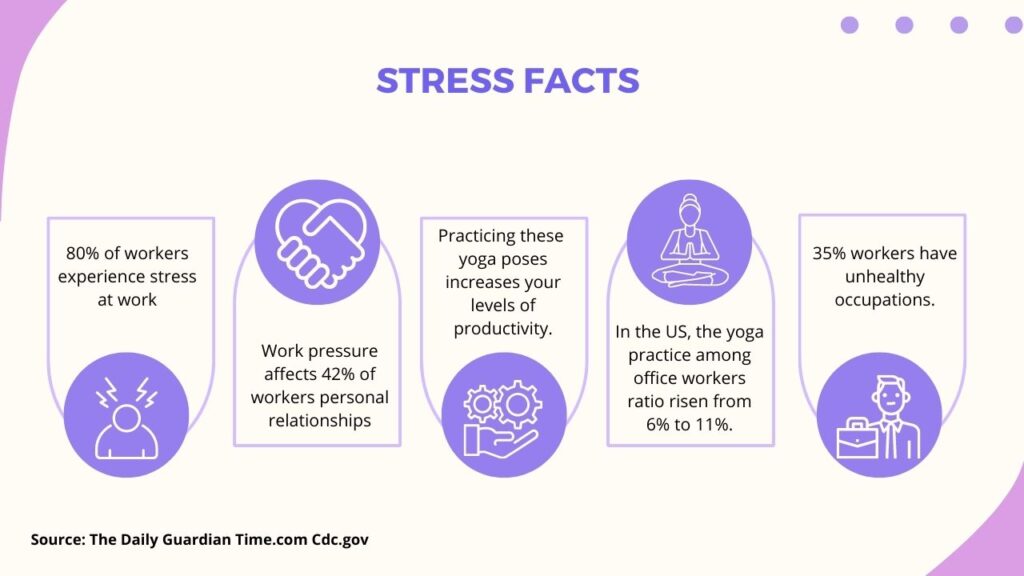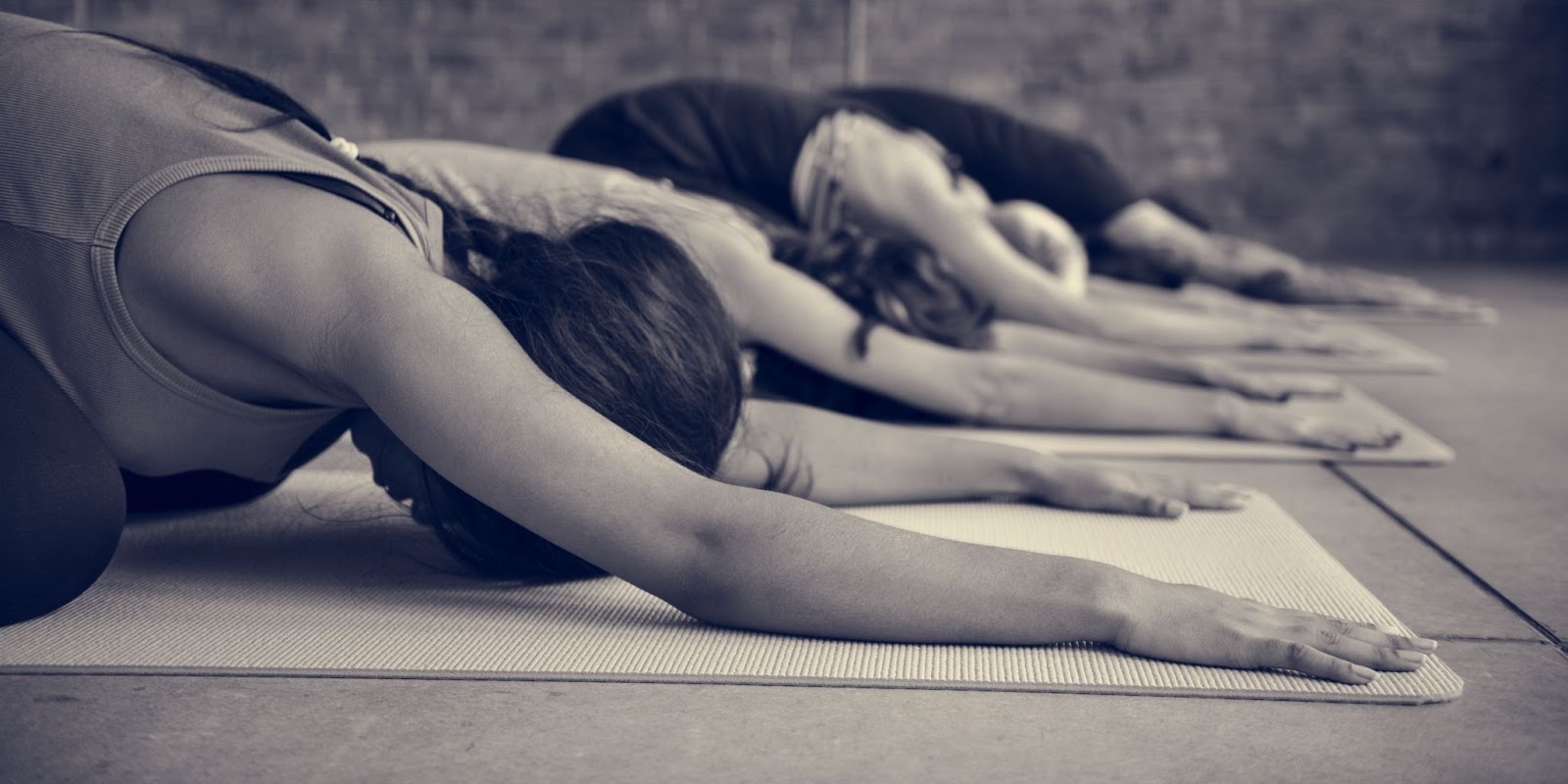With the rise of technology, more and more professions now necessitate spending eight or more hours each day in front of a computer. Although it may make life simpler, the human body was built for movement, and sitting for extended periods can significantly reduce flexibility and mobility. After spending months at a desk, you may start to experience joint pain as well as generalized stiffness that makes it difficult to move and has an impact on your posture. As a result, neck and back pain, sleeplessness, and poor circulation are frequent among office employees.
According to a Gallup poll, a staggering 80% of workers experience stress at work. A further survey revealed that 42% of workers said that work pressure affected their personal relationships, and 35% of workers believed their occupations were unhealthy for their health. Yoga is the ideal alternative to spending the entire day at a desk and offers strategies for managing the pressures that come with it, even though it cannot totally eradicate stress. Yoga improves your flexibility and posture and can even change how you think about the world! Yoga has gained popularity among businesses as more of its advantages are recognized.

Why Yoga Is The Best Solution For Exercising?
Yoga is the ideal alternative to spending the entire day at a desk and offers strategies for managing stress. In the US, the yoga practice among office workers ratio rose from 6% to 11%. Yoga helps ease tension and stress. It also tones muscles and detoxifies the body.
What Are The 4 Exercises That One Can Do At Their Desk?
Specific yoga exercises will help you feel the serenity and relieve stress with the help of a meditation course for anxiety. After spending too many hours on spreadsheets, these courses are there for your rescue. These poses came with long-term advantages that slowly show their magic. When you practice these yoga poses at your workplace, it increases your levels of productivity. Spend more than 2 minutes on every posture and the whole practice in just 10 minutes.
-
Shoulder Rolls
If you've spent a lot of time sitting still, moving around is one of the finest things you can do for your back. The trapezius muscle, which is present in the upper shoulders and back, is helped to relax by this specific action.
Inhale as you raise your right shoulder to your ear while sitting upright. Breathe out as you slowly rotate your shoulder back and out of the way of your ear. Roll your shoulders 3 times, alternating between the right and left.
-
Neck Stretch
This stretch is particularly beneficial for a stiff or strained neck. It lengthens and extends the neck in a way that you can feel relaxed, giving the cervical spine's vertebrae room to move around.
Avoid having the back of the chair touches your back as you sit erect. You might want to use your left hand to grip the side of your chair seat. Inhale, and without lifting your right shoulder or rotating your head, lower your right ear near your right shoulder. As you inhale and exhale, notice how your neck's left side is being stretched.
Reach over your head, raise your right hand on the left side of your head, and slowly pull your neck away from your shoulders to achieve a deeper stretch. You can simultaneously pull your left shoulder aside from your neck by firmly holding onto the chair with your left hand.
Imagine your vertebral muscles relaxing and your neck stretching. Maintain the posture for at least 5 more breaths before releasing your left hand from the chair and using your left hand to massage your neck and shoulders. Lift the head slowly, then swap sides to continue.
-
Chair Twist
The remedy for prolonged sitting is to practice a chair twist. All of the muscles in your spine that have been fixed into position by prolonged sitting will begin to relax once you have twisted, especially those in your middle back.
Spin your thighs toward the chair's right side as you sit forward so that you are seated diagonally on the seat. Bring your thighs as near as you can to the arm rest if it is on the side of the chair. Take a deep breath in and extend your right arm upward. Taking a grip on the chair back, move your arm to the opposite side of the chair as you exhale. Place the left hand on the right chair or knee. Expand your spine as you inhale. By holding your right palm against the back of the chair as you exhale, you can further your twist to the right. Imagine the shoulder blades descending as though they were weighted. Inhale deeply into your ribcage. Twist your body gently a little bit further while consciously relaxing your back muscles. Hold the position for ten to fifteen breaths. With an exhalation, come back to your center and do the reverse side.
-
Back And Shoulder Release
- Sit on a chair with your feet parallel to one another and spaced about 2.5 feet apart. Leaning forward, rest your forearms on the inside of your thighs. With your forearms, extend your inner thighs. Feel the strain in your inner thighs as you take a deep breath in and out.
- Assure that your feet are side by side and that your knees are squarely above your heels. Your ribs should be resting on your thighs, and your armpits should be pointing toward your knees as you slowly extend your arms back to the ground. Put your hands at the opposing elbows while crossing your arms. Continue taking deep breaths.
- Extend your arms in front of you toward a desk or a wall for a deeper back stretch. Return to a correct posture by rolling up slowly and arching your back.
Wrapping it Up
Yoga can benefit both the physical and mental wellness of your staff members. Yoga positions might lessen physical discomfort, work-related stress, and absenteeism. Your staff will be more productive and driven to work if their energy levels are higher. Additionally, a yoga program is affordable and only needs 10–20 minutes daily from your staff to gain the benefits. So don't wait to introduce yoga to your workplace and start enjoying its advantages.


